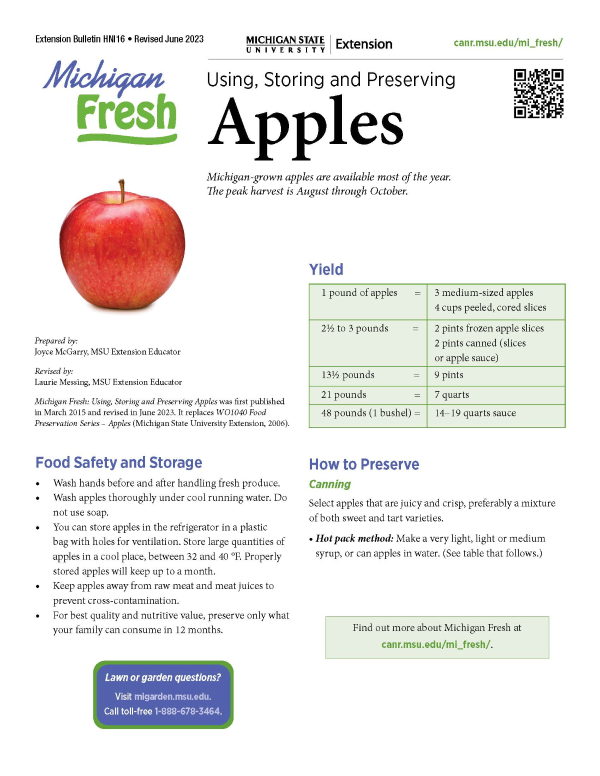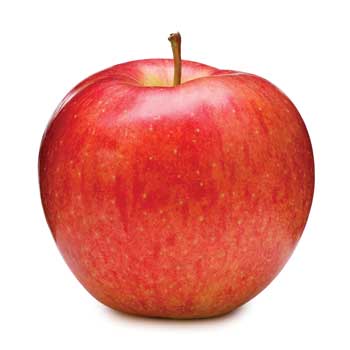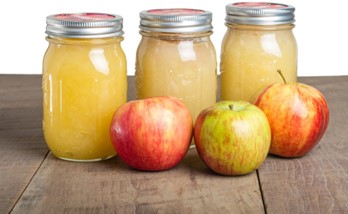
Michigan Fresh: Using, Storing, and Preserving Apples (HNI16)
DOWNLOADJuly 10, 2023 - Joyce McGarry and Laurie Messing, Michigan State University Extension
This Document is offered in: English, Arabic, Espanol
 Recommended varieties
Recommended varieties
Jonathan, Empire, Ida Red, McIntosh and Golden Delicious varieties are recommended for baking and cooking.
Food safety and storage
- Wash hands before and after handling fresh produce.
- Wash apples thoroughly under cool running Do not use soap.
- You can store apples in the refrigerator in a plastic bag with holes for Store large quantities of apples in a cool place, between 32 and 40 °F. Properly stored apples will keep up to a month. Store canned apple products in a cool, dry area.
- Keep apples away from raw meat and meat juices to prevent cross contamination.
- For best quality and nutritive value, preserve only what your family can consume in 12 months.
Yield
|
1 pound of apples |
3 medium-sized apples 4 cups peeled, cored slices |
|
2 1/2 to 3 pounds |
2 pints frozen apple slices 2 pints canned (slices or apple sauce) |
|
13 1/2 pounds |
9 pints |
|
21 pounds |
7 quarts |
|
48 pounds (1 bushel) |
14-19 quarts sauce |
How To Preserve
Canning apples
Select apples that are juicy and crisp, preferably a mixture of both sweet and tart varieties.
-
Hot pack method: Make a very light, light or medium syrup, or can apples in water. (See table that follows.)
|
Preparing and Using Syrups |
||||||
|
|
Measures of water and sugar |
|
||||
|
Syrup type |
Approx. % sugar |
For 9-pt load (1) |
For 7-qt load |
Fruits commonly packed in syrup (2) |
||
|
|
|
Cups water |
Cups sugar |
Cups water |
Cups sugar |
|
|
Very light |
10 |
6½ |
¾ |
10½ |
1¼ |
Approximates natural sugar levels in most fruits and adds the fewest calories. |
|
Light |
20 |
5¾ |
1½ |
9 |
2¼ |
Very sweet fruit. Try a small amount the first time to see if your family likes it. |
|
Medium |
30 |
5¼ |
2¼ |
8¼ |
3¾ |
Sweet apples, sweet cherries, berries, grapes. |
|
Heavy |
40 |
5 |
3¼ |
7¾ |
5¼ |
Tart apples, apricots, sour cherries, gooseberries, nectarines, peaches, pears, plums. |
|
Very heavy |
50 |
4¼ |
4¼ |
6½ |
6¾ |
Very sour fruit. Try a small amount the first time to see if your family likes it. |
- This amount is also adequate for a 4-quart load.
- Many fruits that are typically packed in heavy syrup are excellent and tasteful products when packed in lighter The USDA recommends that lighter syrups be tried, since they contain fewer calories from added sugar.
This table is adapted from “Table 1. Preparing and Using Syrups” from Selecting, Preparing and Canning Fruit on the National Center for Home Food Preservation website at https://nchfp.uga.edu/how/can_02/syrups.html. That table was adapted from the USDA’s Complete Guide to Home Canning (Agricul- ture Information Bulletin No. 539). Revised 2015.
(Canning apples, continued.)
Wash, peel, core and slice apples into ½-inch wedges.
To prevent darkening, add 1 teaspoon ascorbic acid to 1 gallon water. Remove apples from anti-darkening solution and drain well. In a saucepan, add 2 cups water or syrup per 5 pounds of sliced apples. Boil 5 minutes, stirring occasionally. Fill hot jars with hot slices and hot syrup or water, leaving ½-inch headspace. Remove air bubbles, adjust headspace if needed, wipe jar rims with clean paper towel, Remove air bubbles. Wipe jar rims. Adjust lids. Process in a boiling-water bath. Let jars stand undisturbed on the counter for 12 to 24 hours, then remove rings, check to make sure lids are sealed, wash jars, label, date and store.
|
Recommended process time (in minutes) for apples, sliced in a boiling-water canner. |
|||||
|
|
Process time at altitudes of |
||||
|
Style of pack |
Jar size |
0 - 1,000 ft |
1,001 - 3,000 ft |
3,001 - 6,000 ft |
Above 6,000 ft |
|
Hot |
Pints or quarts |
20 |
25 |
30 |
35 |
|
Recommended process time (in minutes) for apples, sliced in a dial-gauge pressure canner. |
||||||
|
|
Canner pressure (PSI) at altitudes of |
|||||
|
Style of pack |
Jar size |
Process time |
0 - 2,000 ft |
2,001 - 4,000 ft |
4,001 - 6,000 ft |
6,001 - 8,000 ft |
|
Hot |
Pints or quarts |
8 |
6 lb. |
7 lb. |
8 lb. |
9 lb. |
|
Recommended process time (in minutes) for apples, sliced in a weighted-gauge pressure canner. |
||||
|
|
Canner pressure (PSI) at altitudes of |
|||
|
Style of pack |
Jar size |
Process time (min.) |
0 - 1,000 ft |
Above 1,000 ft |
|
Hot |
Pints or quarts |
8 |
5 lb. |
10 lb. |
Let jars sit undisturbed for 12 to 24 hours, check lids to be sure they’ve sealed, remove rings, wash jars, date, label and store. Food in jars that do not seal must be reprocessed in a clean jar with a new lid within 24 hours, refrigerated or frozen.
Tables were adapted from the National Center for Home Food Preservation (NCHFP), Selecting, Preparing and Canning Fruit: Apples-Sliced¸ reviewed February 2018 (https://nchfp.uga.edu/how/can_02/apple_sliced.html). The NCHFP adapted them from the Complete Guide to Home Canning (Agriculture Information Bulletin, No. 539). USDA, 2015.
Applesauce 
Wash, peel, and core apples. If desired, slice apples into water containing ascorbic acid to prevent browning. Placed drained slices in an 8- to 10-quart pot. Add ½ cup water. Stirring occasionally to prevent burning, heat quickly until tender (5 to 20 minutes, depending on maturity and variety). Press through a sieve or food mill, or skip the pressing step if you prefer chunk-style sauce. Sauce may be packed without sugar. If desired, add ⅛ cup sugar per quart of sauce. Taste and add more, if preferred. Reheat sauce to boiling. Fill jars with hot sauce, leaving ½-inch headspace. Adjust lids and process.
Recipe for applesauce from the National Center for Home Food Preservation (NCHFP), Selecting, Preparing and Canning Fruit: Applesauce, reviewed February 2018 (https://nchfp.uga.edu/ how/can_02/applesauce.html). The NCHFP adapted it from the Complete Guide to Home Canning (Agriculture Information Bulletin, No. 539). USDA, 2015.
See table that follows for water bath canning applesauce. For pressure canning guidelines, refer to (https://nchfp. uga.edu/how/can_02/applesauce.html).
|
Recommended process time (in minutes) for applesauce in a boiling-water canner. |
|||||
|
|
Process time at altitudes of |
||||
|
Style of pack |
Jar size |
0 - 1,000 ft |
1,001 - 3,000 ft |
3,001 - 6,000 ft |
Above 6,000 ft |
|
Hot |
Pints |
15 |
20 |
20 |
25 |
|
Quarts |
20 |
25 |
30 |
35 |
|
Freezing
Select full-flavored apples that are crisp and firm, not mealy in texture. Wash, peel and core. Slice medium apples into twelfths, large ones into sixteenths.
Syrup Pack is preferred for apples to be used for uncooked desserts or fruit cocktail. A sugar or dry pack is good for pie making.
Syrup Pack – Use cold 40% syrup. To prevent browning, add ½ teaspoon (1500 mg) ascorbic acid to each quart of syrup.
Slice apples directly into syrup in container starting with ½ cup syrup to a pint container. Press fruit down in containers and add enough syrup to cover. Leave headspace. Place a small piece of crumpled water-resistant paper on top to hold fruit down. Seal, label, date and freeze.
Sugar Pack – To prevent darkening, dissolve ½ teaspoon (1500 mg) ascorbic acid in 3 tablespoons water. Sprinkle over the fruit. Apple slices can also be steam blanched for 1½ to 2 minutes.
Mix ½ cup sugar with 1 quart (1¼ pounds) of fruit. Pack apples into containers and press fruit down, leaving head- space. Seal, label, date and freeze.
Dry Pack – Follow the directions for Sugar Pack, omitting the sugar. Treated apple slices can also be frozen first on a tray and then packed into containers as soon as they are frozen.
The Freezing section is adapted from Freezing – Apples (https://nchfp. uga.edu/how/freeze/apple.html) from the National Center for Home Food Preservation who extracted it from Andress, E. and Har- rison, J.A., So Easy to Preserve, (Bulletin 989). (6th ed.). University of Georgia Cooperative Extension.
|
Syrups for Use in Freezing Fruits |
||||
|
Type of syrup |
Percent sugar* |
Cups of sugar** |
Cups of water |
Yield of syrup in cups |
|
Very light |
10 |
½ |
4 |
4½ cups |
|
Light |
20 |
1 |
4 |
4¾ cups |
|
Medium |
30 |
1¾ |
4 |
5 cups |
|
Heavy |
40 |
2¾ |
4 |
5⅓ cups |
|
Very heavy |
50 |
4 |
4 |
6 cups |
*Approximate
**In general, up to one-fourth of the sugar may be replaced by corn syrup or mild-flavored honey. A larger proportion of corn syrup may be used if a very bland, light-colored type is selected.
References:
-
Andress, E., & Harrison, J. A. (2014). So easy to preserve (Bulletin 989). (6th ed.). University of Georgia Cooperative Extension.
-
National Center for Home Food Preservation. http://nchfp.uga.edu/
-
U.S. Department of Agriculture. (2015). Complete guide to home canning (Rev. ed.). (Agriculture Information Bulletin No. 539). http://nchfp.uga.edu/publications/ publications_usda.html
More information



 Print
Print Email
Email